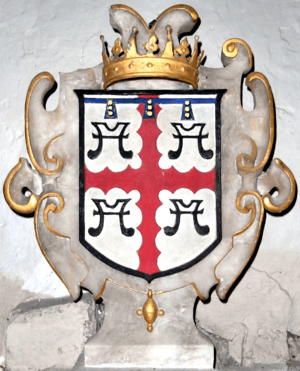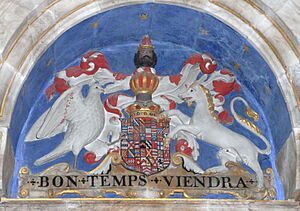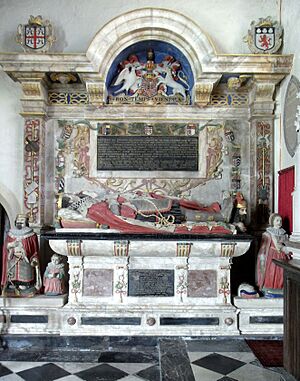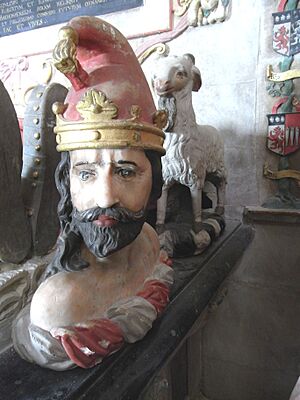William Bourchier, 3rd Earl of Bath facts for kids
Quick facts for kids
William Bourchier, 3rd Earl of Bath
|
|
|---|---|
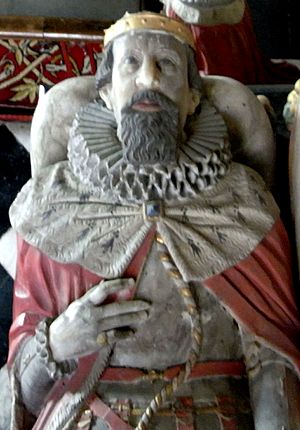
Effigy of William Bourchier, 3rd Earl of Bath (died 1623), wearing an earl's coronet and robes with ermine collar with sapphire clasp, St Peter's Church, Tawstock, Devon
|
|
| Born | 29 September 1557 Devon
|
| Died | 12 July 1623 |
| Resting place | St. Peter's Church, Tawstock, Devon |
| Successor | Edward Bourchier, 4th Earl of Bath |
| Spouse(s) |
|
| Children | Richard Bourchier, Lord FitzWarin Edward Bourchier, 4th Earl of Bath Frances Bourchier |
| Parent(s) | John Bourchier, Lord FitzWarin Frances Kitson |
William Bourchier, 3rd Earl of Bath (born 29 September 1557 – died 12 July 1623) was an important English nobleman. He served as the Lord Lieutenant of Devon, which meant he was the monarch's main representative in the county. His family home was Tawstock Court in North Devon. He rebuilt parts of this large house in 1574, in the popular Elizabethan style of the time.
Contents
Early Life and Family
William Bourchier was born in Devon on 29 September 1557. He was the oldest son of John Bourchier, Lord FitzWarin. Sadly, his father passed away shortly after William was born. His mother was Frances Kitson. William became the Earl of Bath when his grandfather, John Bourchier, 2nd Earl of Bath, died in 1561.
Marriages and Children
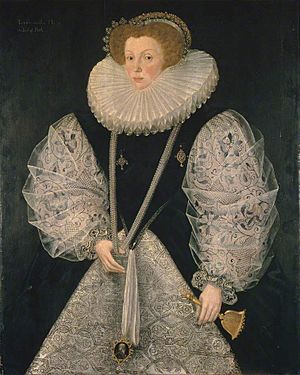
William Bourchier married two times:
First Marriage
- He first married Mary Cornwallis in secret on 15 December 1578. She was the daughter of Sir Thomas Cornwallis. This marriage was arranged by William's uncle, Sir Thomas Kytson. However, William's mother, Frances Kytson, did not approve of the marriage. Because of this, the marriage was later cancelled by a judge on 28 April 1581.
Second Marriage
- In 1583, he married Lady Elizabeth Russell. She was the daughter of Francis Russell, 2nd Earl of Bedford. Her father was a very powerful and wealthy man in Devon. William and Elizabeth had four children:
- John Bourchier, Lord FitzWarin (born 1585, died 1587). He was their first son.
- Robert Bourchier, Lord FitzWarin (born 1588, died 1588). He was their second son.
- Edward Bourchier, 4th Earl of Bath (1590–1636). He was their oldest son who lived to become the next Earl.
- Lady Frances Bourchier (1587–1612). She died at age 25 and never married. She worked in the household of Princess Elizabeth. A special monument for her can be found in the Bedford Chapel in Chenies, Buckinghamshire.
Death and Burial
William Bourchier and his wife, Elizabeth, are buried together. Their resting place is in the choir area of St. Peter's Church in Tawstock, Devon. You can visit their impressive monument there.
Monument at Tawstock Church
Inside St Peter's Church in Tawstock, there is a grand monument dedicated to William Bourchier, 3rd Earl of Bath, and his wife Elizabeth Russell. It shows statues of them lying down. Next to them are smaller statues of their children kneeling.
The monument was carefully repaired in 1999. Workers replaced old iron parts with new stainless steel to prevent damage. They also repainted the monument to make it look new again.
Family Crests
At the feet of William's statue, you can see his family's crest. It's a man's head wearing a special pointed hat. This crest has an interesting story. It's said to represent a pagan king that an ancestor of the Bourchier family defeated in a fight long ago.
At his wife's feet, you can see the Russell family crest, which is a goat.
Epitaph and Hidden Messages
Above the statues of William and Elizabeth, there is a black stone tablet with an inscription in Latin. This message praises William Bourchier. It says he was a good and noble man who served Devon with honesty for about 30 years. It also mentions that he was very religious, kind to others, and helped the poor. He died on 12 July 1623, at 65 years old, leaving behind his son Edward to become the next Earl.
On the base of the monument, there's another tablet with clever hidden messages. It includes puzzles like anagrams (where letters are rearranged to form new words) and chronograms (where certain letters, when added up as Roman numerals, give a date). For example, one message has capital letters that add up to 1623, the year he died. These messages were a way to honor him and share clever thoughts with those who visited the monument.
Other Monuments
You can also find the family symbols (arms) of William Bourchier, 3rd Earl of Bath, in other places. For example, in Weare Giffard Hall, about eight miles from Tawstock, there is a shield from 1599 showing his family's arms.
Sources
- http://www.tribalpages.com/tribes/royalancestralc
- tudorplace.com.ar Accessed 30 August 2008
- thepeerage.com. Retrieved 30 August 2008
- churchmonumentssociety.org. Retrieved 30 August 2008
- Vivian, Lt.Col. J.L., (Ed.) The Visitations of the County of Devon: Comprising the Heralds' Visitations of 1531, 1564 & 1620. Exeter, 1895.
| Political offices | ||
|---|---|---|
| Preceded by The 2nd Earl of Bedford |
Lord Lieutenant of Devon 1586–1623 |
Succeeded by The 4th Earl of Bedford |
| Peerage of England | ||
| Preceded by John Bourchier |
Earl of Bath 1561–1623 |
Succeeded by Edward Bourchier |


